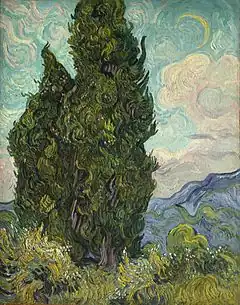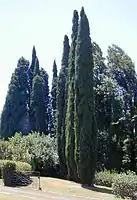| Mediterranean cypress | |
|---|---|
 | |
| Mediterranean Cypress foliage and cones | |
| Scientific classification | |
| Kingdom: | Plantae |
| Clade: | Tracheophytes |
| Clade: | Gymnospermae |
| Division: | Pinophyta |
| Class: | Pinopsida |
| Order: | Cupressales |
| Family: | Cupressaceae |
| Genus: | Cupressus |
| Species: | C. sempervirens |
| Binomial name | |
| Cupressus sempervirens | |
 | |
| Green: probable natural range in the Mediterranean Basin Orange: range including human introductions Red (small areas): Residual natural stands | |
Cupressus sempervirens, the Mediterranean cypress (also known as Italian cypress,[1] Tuscan cypress, Persian cypress, or pencil pine), is a species of cypress native to the eastern Mediterranean region and Iran. Cupressus sempervirens is a seeded vascular plant, meaning that it contains both xylem and phloem. Since it is a seeded plant, it uses seeds to reproduce.[2] It has many uses that can contribute to medicine and other things that are beneficial, whether that be the seeds that it produces or the oil that comes from the leaves.[3] It is well adapted to the conditions and the environment that it lives in.[4] Cupressus sempervirens is widely present in culture, most notably in Iran, where it is both a sacred tree and is a metaphor for "the graceful figure of the beloved".[5]
Description
Cupressus sempervirens is a medium-sized coniferous evergreen tree to 35 m (115 ft) tall, with a conic crown with level branches and variably loosely hanging branchlets.[6] It is very long-lived, with some trees reported to be over 1,000 years old.[7]
The foliage grows in dense sprays, dark green in colour. The leaves are scale-like, 2–5 mm long, and produced on rounded (not flattened) shoots. The seed cones are ovoid or oblong, 25–40 mm long, with 10-14 scales, green at first, maturing brown about 20–24 months after pollination. The male cones are 3–5 mm long, and release pollen in late winter. A cone on C. sempervirens can withstand years of being sealed, in this scenario a fire could potentially unseal the cone.[2] It is moderately susceptible to cypress canker, caused by the fungus Seiridium cardinale, and can suffer extensive dieback where this disease is common. The species name sempervirens comes from the Latin for 'evergreen'.[8]
It is also known as "the churchyard cypress," often being found standing (as if sentinels) surrounding a graveyard.
The Cupressis sempervirens are able to grow their branches in two different ways, the first would be their standard branching going out laterally.[9] The other form of branching would be more upwards rather than laterally.[9] Their seeds can remain sealed for a long period of time, in this case the cones would need to make contact with heat to unseal the seeds.[2]
Uses
Mediterranean cypress has been widely cultivated as an ornamental tree for millennia away from its native range, mainly throughout the whole Mediterranean region, and in other areas with similar hot, dry summers and mild, rainy winters, including California, southwest South Africa and southern Australia. It can also be grown successfully in areas with cooler, moister summers, such as the British Isles, New Zealand and the Pacific Northwest (coastal Oregon, Washington and British Columbia). It is also planted in Florida and parts of the coastal southern United States as an ornamental tree. In some areas, particularly the United States, it is known as "Italian" or "Tuscan cypress". Commonly seen throughout New Mexico, the Mediterranean cypress is also known as the "drama tree" because of its tendency to bend with even the slightest of breezes.

The vast majority of the trees in cultivation are selected cultivars with a fastigiate crown, with erect branches forming a narrow to very narrow crown often less than a tenth as wide as the tree is tall. The dark green "exclamation mark" shape of these trees is a highly characteristic signature of Mediterranean town and village landscapes. Formerly, the species was sometimes separated into two varieties, the wild C. sempervirens var. sempervirens (syn. var. horizontalis), and the fastigiate C. s. var. pyramidalis (syn. var. fastigiata, var. stricta), but the latter is now only distinguished as a Cultivar Group, with no botanical significance.
It is also known for its very durable, scented wood, used most famously for the doors of St. Peter's Basilica in the Vatican City, Rome. Cypress used to be used in distilleries as staves to hold mash ferments to make alcohol before the invention of stainless steel.
In cosmetics it is used as astringent, firming, anti-seborrheic, anti-dandruff, anti-aging and as fragrance.[10] It is also the traditional wood used for Italian harpsichords.[11]

C. sempervirens finds a litany of uses including as wood, in traditional medicine, and for other therapeutic purposes. The wood is insect-repellent; hence its use in furniture - i.e. for pantry cabinets - while the cypress's oil is marketed as massage liniment.
The dry seeds that come from the Cupressus sempervirens are able to help people reduce their skin conditions like acne or help heal any cuts or scrapes that a person may have.[3] The oil that come from the leaves of the plant can help cure people from any minor infections that might have, like nose congestion for example.[3] It can also prevent damage to land that are caused by violent weather.[12]
Habitats
Cupressus sempervirens grows primarily in places with wet winters and hot summers; in the spring and autumn, the tree grows out its roots, stems, and leaves.[4] Like most plants, Cupressus sempervirens requires light for such growth.[7] Since the tree lives in a very wet winter environment, its roots are adapted to be very stubby, for easier gathering of the material and nutrients that the soil provides for them.[4] Another benefit to their stubby roots is that they help them survive the harsh summer heat. The roots of Cupressus sempervirens are adapted to function effortlessly in either low or high pH environments.[3] The more mature the plant is, the more it can withstand below-freezing temperatures.[4]
In culture
Iran
_(4688859421).jpg.webp)
In Persian, C. sempervirens is called the "Graceful Cypress" (sarv-e nāz), and has a distinguished presence in culture, poetry and gardens. It bears several metaphors, including the "graceful figure and stately gait of the beloved".[5] Iranians considered cypress to be a relic of Zoroaster. A Zoroastrian tradition recorded by Daqiqi maintains that King Vishtaspa, after converting to Zoroastrianism, ordered to plant a cypress brought from paradise by Zoroaster near the first fire temple.[5]
In the words of the Shahnameh, cypress represents a single-minded, professional and wise man. In ancient Iran, at Yalda night, a tree called Yalda tree was decorated, which was generally made of cypress and pine trees. It is said that the decoration of cypress and pine in Christmas was adapted from ancient Iran, because the Iranians looked at these two trees, especially the cypress, as a symbol of resistance against darkness and cold, and they stood in front of the cypress on the first day of January. And they vowed to be strong and stable until the next year and plant another cedar sapling. Also, according to Iranian beliefs, greens at the beginning of the year are a sign of blessing throughout that year, and based on this belief, the custom of planting greens at the beginning of the year and at the same time as Nowruz celebration gradually replaced the Cypress tree. Cypress, specifically C. sempervirens, was the first choice for Iranian gardens. In all of the famous Persian Gardens, such as Fin Garden, Shazdeh Garden, Dowlat-Abad, and others, this tree plays a central role in their design. The oldest living cypress is the Sarv-e-Abarkooh in Iran's Yazd Province. Its age is estimated to be approximately 4,000 years.[13]
Symbolism
In classical antiquity, the cypress was a symbol of mourning, and in the modern era it remains the principal cemetery tree in both the Muslim world and Europe. In the classical tradition, the cypress was associated with death and the underworld because it failed to regenerate when cut back too severely. Athenian households in mourning were garlanded with boughs of cypress.[14] Cypress was used to fumigate the air during cremations.[15] It was among the plants that were suitable for making wreaths to adorn statues of Pluto, the classical ruler of the underworld.[16]
The poet Ovid, who wrote during the reign of Augustus, records the best-known myth that explains the association of the cypress with grief. The handsome boy Cyparissus, a favorite of Apollo, accidentally killed a beloved tame stag. His grief and remorse were so inconsolable that he asked to weep forever. He was transformed into cupressus sempervirens, with the tree's sap as his tears.[17] In another version of the story, it was the woodland god Silvanus who was the divine companion of Cyparissus and who accidentally killed the stag. When the boy was consumed by grief, Silvanus turned him into a tree, and thereafter carried a branch of cypress as a symbol of mourning.[18]
In Greek mythology, besides Cyparissus, the cypress is also associated with Artemis and Hecate, a goddess of magic, crossroads and the underworld. Ancient Roman funerary rites used it extensively.
The most famous Muslim cemetery in Turkey where C. sempervirens is used widely is Istanbul Karacaahmet Cemetery. In Istanbul Turkish the tree is referred to as "mezarlık servisi" (cemetery tree); its common name in Turkish and the name used in Turkish forestry is "kara selvi" (black cypress). Cypresses are mentioned extensively in the Shahnameh, the great Iranian epic poem by Ferdowsi.
In Jewish tradition, the cypress was held to be the wood used to build Noah's Ark and The Temple, and is mentioned as an idiom or metaphor in biblical passages, either referencing the tree's shape as an example of uprightness or its evergreen nature as an example of eternal beauty or health. It is popular in modern Israeli cemeteries, with contemporary explanation being that its shape resembles a candle and its being an evergreen symbolized the immortality of the soul.
In popular culture the Italian cypress is often stereotypically associated with vacation destinations to the Mediterranean region; Italy in particular. The tree has been seen on travel posters for decades.[19][20]
.jpg.webp) Isle of the Dead (1883) by Arnold Böcklin. Third version in a series of five.
Isle of the Dead (1883) by Arnold Böcklin. Third version in a series of five. Cypresses (1889) by Vincent van Gogh, Saint-Rémy-de-Provence. Other van Gogh cypress paintings include Wheat Field with Cypresses and The Starry Night.
Cypresses (1889) by Vincent van Gogh, Saint-Rémy-de-Provence. Other van Gogh cypress paintings include Wheat Field with Cypresses and The Starry Night. Fastigiate Mediterranean cypress C. sempervirens 'Stricta', planted in Hawaii
Fastigiate Mediterranean cypress C. sempervirens 'Stricta', planted in Hawaii
Other characteristics
In July 2012, a forest fire, lasting five days, devastated 20,000 hectares of forest in the Valencian village of Andilla. However, amid the charred landscape, a group of 946 cypress trees about 22 years old was virtually unharmed, and only 12 cypresses were burned. Andilla cypresses were planted by the CypFire European project studying various aspects of the cypresses, including fire resistance.[21]
References
- ↑ BSBI List 2007 (xls). Botanical Society of Britain and Ireland. Archived from the original (xls) on 2015-06-26. Retrieved 2014-10-17.
- 1 2 3 "Cupressus sempervirens (Mediterranean cypress) description". www.conifers.org. Retrieved 2023-10-17.
- 1 2 3 4 Selim, Samy A; Adam, Mohammed E; Hassan, Sherif M; Albalawi, Abdulrhman R (December 2014). "Chemical composition, antimicrobial and antibiofilm activity of the essential oil and methanol extract of the Mediterranean cypress (Cupressus sempervirens L.)". BMC Complementary and Alternative Medicine. 14 (1): 179. doi:10.1186/1472-6882-14-179. ISSN 1472-6882. PMC 4052795. PMID 24890383.
- 1 2 3 4 "Supporting EFSA assessment of the EU environmental suitability for exotic forestry pests: Final Report". EFSA Supporting Publications. 11 (3). March 2014. doi:10.2903/sp.efsa.2014.en-434. ISSN 2397-8325.
- 1 2 3 Aʿlam, Hūšang (2020-08-30), "CYPRESS", Encyclopaedia Iranica Online, Brill, retrieved 2023-10-30
- ↑ See also Uses section for the differing cultivated variants
- 1 2 Mauri, Achille; Girardello, Marco; Strona, Giovanni; Beck, Pieter S. A.; Forzieri, Giovanni; Caudullo, Giovanni; Manca, Federica; Cescatti, Alessandro (2022-02-03). "EU-Trees4F, a dataset on the future distribution of European tree species". Scientific Data. 9 (1): 37. Bibcode:2022NatSD...9...37M. doi:10.1038/s41597-022-01128-5. ISSN 2052-4463. PMC 8813948. PMID 35115529.
- ↑ Rojas-Sandova, J (2022-01-07). Cupressus sempervirens (Mediterranean cypress) (Report). doi:10.1079/cabicompendium.17105.
- 1 2 Weick, Cynthia Wagner; Aamir, Naela; Reichart, Jayme (June 2023). "The Ethnobotanical Evolution of the Mediterranean Cypress (Cupressus sempervirens)". Economic Botany. 77 (2): 203–221. doi:10.1007/s12231-023-09570-1. ISSN 0013-0001. S2CID 257968346.
- ↑ Carrasco, F. (2009). "Ingredientes Cosméticos". Diccionario de Ingredientes\ 4ª Ed. www.imagenpersonal.net. p. 267. ISBN 978-84-613-4979-1.
- ↑ Hubbard, Frank (1965). Three Centuries of Harpsichord Making. Harvard University Press. p. 201. ISBN 0-674-88845-6.
- ↑ Orhan, Ilkay Erdogan; Tumen, Ibrahim (2015), "Potential of Cupressus sempervirens (Mediterranean Cypress) in Health", The Mediterranean Diet, Elsevier: 639–647, doi:10.1016/b978-0-12-407849-9.00057-9, ISBN 978-0-12-407849-9, PMC 7149725
- ↑ Craig Glenday, ed. (2011). Guinness World Records. BANTAM DELL. p. 95. ISBN 9781904994671.
- ↑ Servius, note to Vergil's Aeneid 3.680.
- ↑ Isidore of Seville, Etymologiae 17.7.34.
- ↑ Natalis Comes, Mythologiae 2.9.
- ↑ Ovid, Metamorphoses 10.106ff.
- ↑ Servius, note to Vergil's Georgics 1.20.
- ↑ "Image: Italian_Lakes,_travel_poster_for_ENIT,_ca._1930.jpg, (3091 × 5015 px)". upload.wikimedia.org. 2009-04-15. Retrieved 2015-09-06.
- ↑ "Image: 01422-2T.jpg, (300 × 453 px)". postercorner.com. Archived from the original on 2015-02-22. Retrieved 2015-09-06.
- ↑ "The curious case of Valencia's flameproof cypresses". sociedad.elpais.com. 14 August 2012. Retrieved 2015-09-06.
Further reading
- Farjon, A. 2013 Cupressus sempervirens. The IUCN Red List of Threatened Species. Version 2014.2
- Farjon, A. (2005). Monograph of Cupressaceae and Sciadopitys. Royal Botanic Gardens, Kew. ISBN 1-84246-068-4.
- Zsolt Debreczy, Istvan Racz (2012). Kathy Musial (ed.). Conifers Around the World (1st ed.). DendroPress. p. 1089. ISBN 978-9632190617.
- Panconesi, A. 2007 The cypress from myth to future. [Italian] 456 p. Ed. Centro Promozione Pubblicità, ISBN 9788888228204
External links
- Cupressus sempervirens—information, genetic conservation units and related resources from the European Forest Genetic Resources Programme (EUFORGEN)
